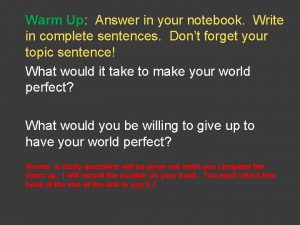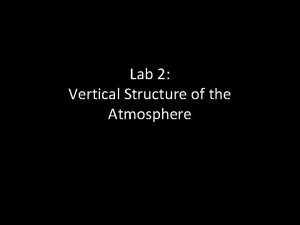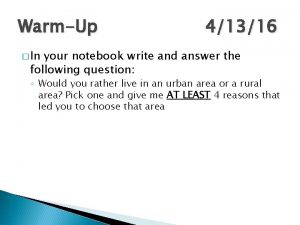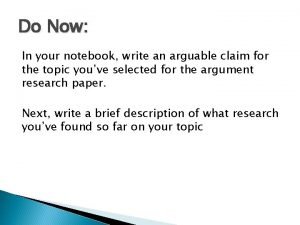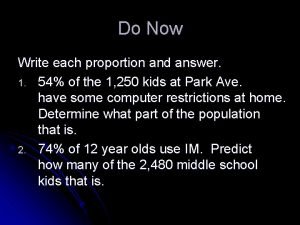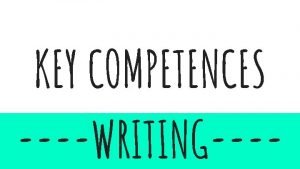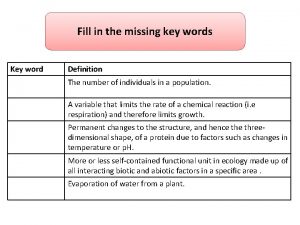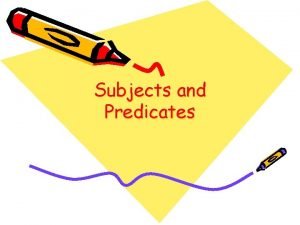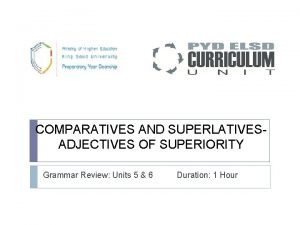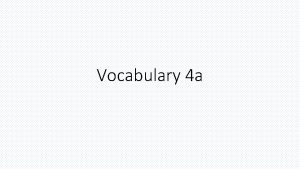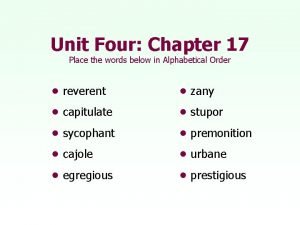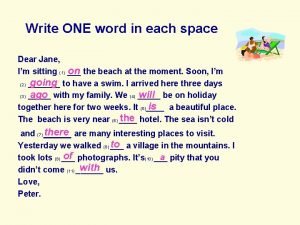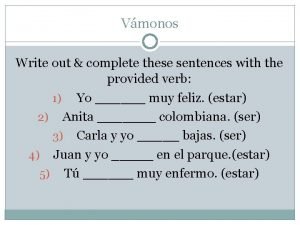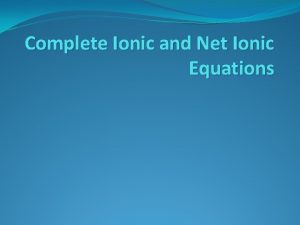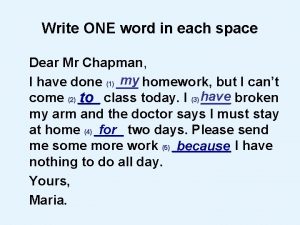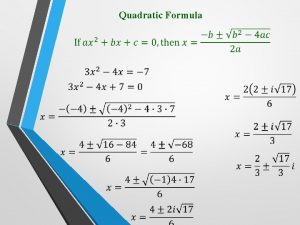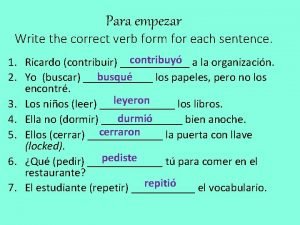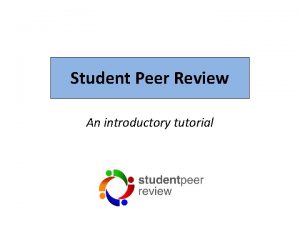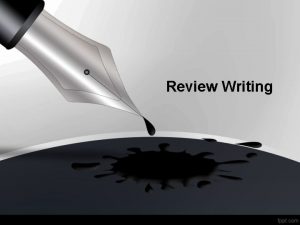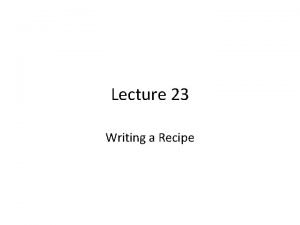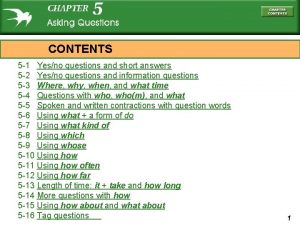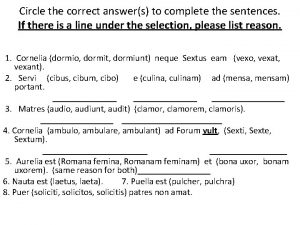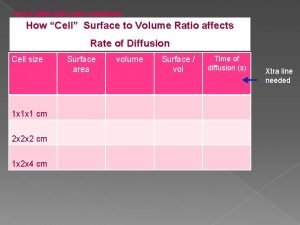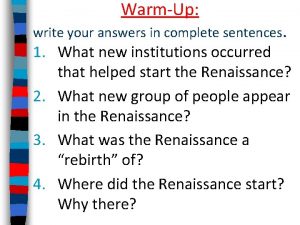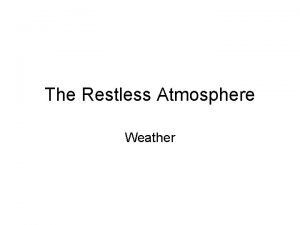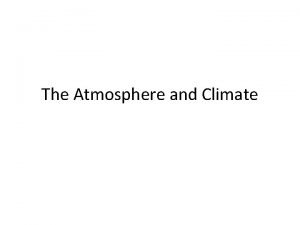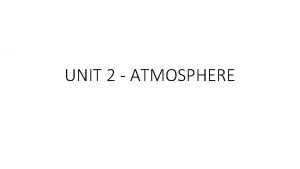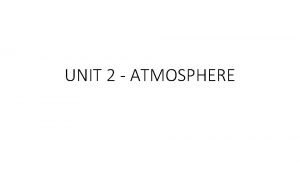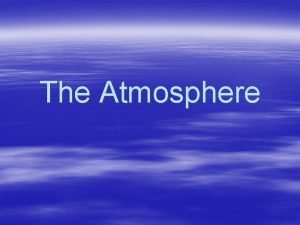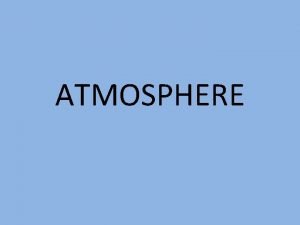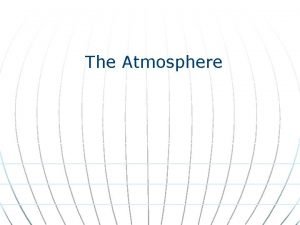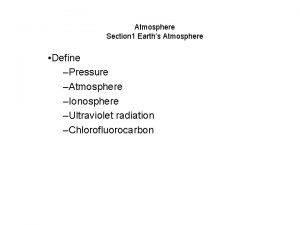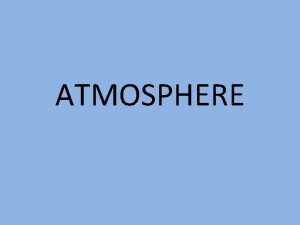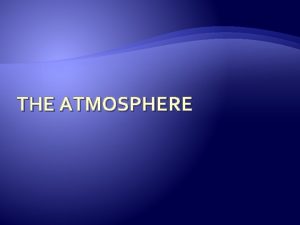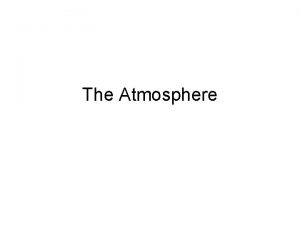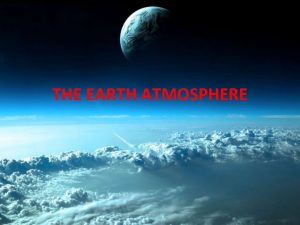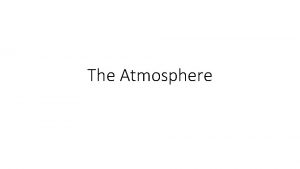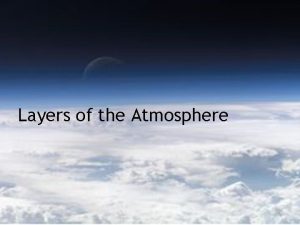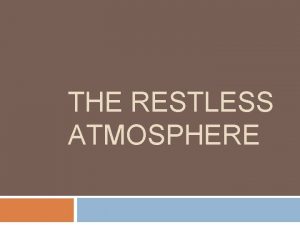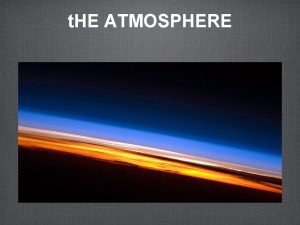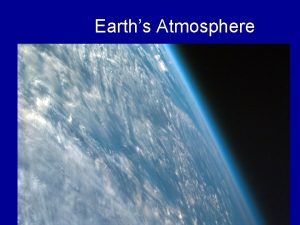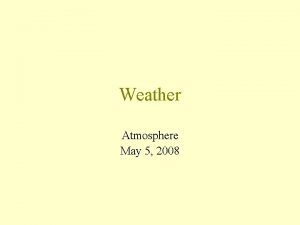Atmosphere Review WarmUp Write your answers in complete


















































- Slides: 50

Atmosphere Review Warm-Up • Write your answers in complete sentences! • 1. Explain the greenhouse effect. • 2. What are three methods of heat transfer in the atmosphere? • 3. What is the purpose of ozone?

Drop in the Bucket What do you think…. How much of Earth’s water is… Freshwater? Non-frozen? Clean and ready to use?

Mini-Movie Marathon Time! https: //www. youtube. com/watch? v=4 b 2 kdc. Eu. Wr 4 https: //www. youtube. com/watch? v=UYROQW 9 IDIg

Water Resources • Water is essential to life on Earth. Humans can live for more than month without food, but we can live for only a few days without water. • Two kinds of water found on Earth: • Fresh water, the water that people can drink, contains little salt. • Salt water, the water in oceans, contains a higher concentration of dissolved salts. • • Most human uses for water, such as drinking and agriculture, require fresh water.

Surface Water • The fresh water on Earth’s land surface. • Found in lakes, rivers, streams, and wetlands.

River Systems • As streams and rivers move across the land, they become a flowing network of water called a river system.

Watersheds • A watershed is the area of land that is drained by a water system. • The amount of water that enters a watershed varies throughout the year. • • Rapidly melting snow as well as spring and summer rains can dramatically increase the amount of water in a watershed. At other times of the year, the river system that drains a watershed may be reduced to a trickle.

Watersheds

Groundwater • Most of the fresh water that is available for human use cannot be seen, as it exists underground. • When it rains, some of the water that falls onto the land flows into lakes and streams. But much of the water percolates through the soil and down into the rocks beneath. • Groundwater is the water that is beneath the Earth’s surface.

Groundwater

Aquifers • An aquifer is an underground formation that stores and allows the flow of groundwater. They are an important water source for many cities. • The water table forms the upper boundary of an aquifer, and most aquifers consist of materials such as rock, sand, and gravel that have a lot of spaces where water can accumulate. • Groundwater can also dissolve rock formations, filling vast caves with water and creating underground lakes.

Aquifers

The Recharge Zone • To reach an aquifer, surface water must travel down through permeable layers of soil and rock. Water cannot reach an aquifer from places where the aquifer is covered by impermeable materials. • The recharge zone is an area in which water travels downward to become part of an aquifer. • • Recharge zones are environmentally sensitive areas because any pollution in the recharge zone can also enter the aquifer.

The Recharge Zone

Wells • A hole that is dug or drilled to reach groundwater is called a well. • • Humans have dug wells to reach groundwater for thousands of years. • We dig wells because ground water may be a more reliable source of water than surface water and because water is filtered and purified as it travels underground.

Water Use and Management • When a water supply is polluted or overused, everyone living downstream can be affected. • A shortage of clean, fresh water is one of the world’s most pressing environmental problems. • According to the World Health Organization, more than 1 billion people lack access to a clean, reliable source of fresh water.

Water Use and Management

Residential Water Use • In the US, the average person uses 300 L (80 Gal) of water per day. • In India, the average person uses 80 L (11 Gal) of water per day.

Water Treatment • Most water must first be made potable. • Potable means suitable for drinking. • Water treatment removes elements such as mercury, arsenic, and lead, which are poisonous to humans even in low concentrations. • These elements are found in polluted water, but they can also occur naturally in groundwater.

Water Treatment • Pathogens are found in water contaminated by sewage or animal feces, but can be removed with water treatment. • A pathogen is a virus, microorganism, or other substance that causes disease. • There are several methods of treating water to make it potable. A common method includes both physical and chemical treatment.

Drinking-Water Treatment

Industrial Water Use • Industry accounts for 19 percent of water used in the world. • Water is used to manufacture goods, to dispose of wastes, and to generate power.

Agricultural Water Use • Agriculture accounts for 67 percent of the water used in the world. Plants require a lot of water to grow, and as much as 80 percent of the water used in agriculture evaporates. • It can take up to 300 L (80 Gal) of water to grow one ear of corn!

Irrigation • Irrigation is a method of providing plants with water from sources other than direct precipitation. • • Many different irrigation techniques are used today. For example, some crops are irrigated by shallow, water filled ditches. • • In the U. S. , high-pressured overhead sprinklers are the most common form of irrigation. However, this method is inefficient because nearly half the water evaporates and never reaches the plant roots.

Irrigation

Water Management • People often live in areas where the natural distribution of surface water is inadequate. • Water management projects have allowed people to live in various places that they otherwise could not, like the US Southwest and other deserts.

Water Diversion • To supply dry regions with water, all or part of a river can be diverted into canals that carry water across great distances.

Dams and Reservoirs • A dam is a structure that is built across a river to control a river’s flow. • A reservoir is an artificial body of water that usually forms behind a dam. Water from a reservoir can be used for flood control, drinking water, irrigation, recreation, and industry. • Hydroelectric dams use the power of flowing water to turn a turbine that generates electrical energy. About 20 percent of the world electrical energy is generated using this method.

Water Conservation • As water sources become depleted, water becomes more expensive. • This is because wells must be dug deeper, water must be piped greater distances, and polluted water must be cleaned up before it can be used. • Water conservation is one way that we can help ensure that everyone will have enough water at a reasonable price.

Water Conservation at Home • • Take shorter showers, and avoid taking full baths. Install low-flow shower heads. Install low-flow aerators in your water faucets at home. Purchase a low-flow toilet, install a water-saving device in your toilet, or place a water-filled bottle in your toilet tank to reduce the water used for each flush. Do not let the water run while brushing your teeth. Fill up the sink rather than letting the water run when you are shaving, washing your face, or washing dishes. Wash only full loads in the dishwasher and washing machines. Water your lawn sparingly.

Desalination • Desalination is the process of removing salt from ocean water. • Some countries in drier parts of the world, such as the Middle East, have built desalination plants to provide fresh water. • Most desalination plants heat salt water and collect the fresh water that evaporates. • Because desalination consumes a lot of energy, the process is too expensive for many nations to consider.

Desalination

Water Pollution • Water pollution is the introduction into water of waste matter or chemicals that are harmful to organisms living in the water or to those that drink or are exposed to the water. • Almost all of the ways that we use water contribute to water pollution. • However, the two underlying causes of water pollution are industrialization and rapid human population growth.

Point-Source Pollution • When you think of water pollution, you probably think of a single source, such as a factory, a wastewater treatment plant, or a leaking oil tanker. These are all examples of point-source pollution. • Point-source pollution is pollution that comes from a specific site.

Point-Source Pollution

Nonpoint-Source Pollution • Nonpoint source pollution is pollution that comes from many sources rather than from a single specific site. An example is pollution that reaches a body of water from streets and storm sewers.

Nonpoint-Source Pollution

Point and Nonpoint Sources of Pollution

Wastewater • After water flows down the drain in the sink, it usually flows through a series of sewage pipes that carry it, along with all the other wastewater in your community, to a wastewater treatment plant. • Wastewater is water that contains wastes from homes or industry. • At a wastewater treatment plant, water is filtered and treated to make the water clean enough to return to a river or lake.

Wastewater Treatment Process

Sewage Sludge • One of the products of wastewater treatment is sewage sludge, the solid material that remains after treatment. • When sludge contains dangerous concentrations of toxic chemicals, it must be disposed of as hazardous waste. It is often incinerated, and then the ash is buried in a secure landfill. • Sludge can be an expensive burden to cities as the volume of sludge that has to be disposed of every year is enormous.

Artificial Eutrophication • Remember that eutrophication happens when lakes or streams contain an abundance of nutrients. • This can be a natural process, but when humans cause it it’s called artificial eutrophication. • Fertilizer runoff from lawns, farms, and gardens is the largest source of nutrients that cause artificial eutrophication. • Phosphates from laundry and dishwashing detergents are also major causes of eutrophication.

Thermal Pollution • Thermal pollution occurs when the temperature of a body of water increases. • This can occur when industries and power plants discharge warm water used for cooling their systems into a body of water. • Rapid changes can cause large fish kills and slower changes can slowly decrease the oxygen in the water, eventually killing many aquatic organisms.

Groundwater Pollution • Pollutants usually enter groundwater when polluted surface water percolates down from the Earth’s surface. • Any pollution of the surface water in an area can affect the groundwater. • Pesticides, herbicides, chemical fertilizer, and petroleum products are common groundwater pollutants. Other sources of pollution include septic tanks, unlined landfills, and industrial wastewater lagoons.

Cleaning Up Groundwater Pollution • Groundwater pollution is one of the most challenging environmental problems in the world. • Groundwater recharges very slowly, so the process for some aquifers to recycle water and purge contaminants can take hundreds of years. • Also, pollution can cling to the materials that make up an aquifer, so even if all of the water in aquifer were pumped out and replaced with clean water, the groundwater could still become polluted.

Ocean Pollution • Pollutants are often dumped directly into the ocean. For example, ships can legally dump wastewater and garbage overboard in some parts of the ocean. • 85% of ocean pollution (including oil, toxic waste, and medical waste) comes from land activities.

Oil Spills • Oceans are also polluted by accidental oil spills. • Each year, approximately 37 million gallons of oil from tanker accidents are spilled into the oceans. • While dramatic, oil spills only account for 5% of oil pollutions in the oceans. • 200 -300 million gallons of oil enters the ocean every year from non-point sources on land.

Water Pollution and Ecosystems • Water pollution cause immediate damage to an ecosystem, but the effects can be far reaching as some pollutants build up in the environment because they do not decompose quickly. • Biomagnification is the accumulation of pollutants at successive levels of the food chain. • Biomagnification has alarming consequences for organisms at the top of the food chain, and is one reason why U. S. states limit the amount of fish people can eat from certain bodies of water.

Water Pollution and Ecosystems

Cleaning Up Water Pollution • The Clean Water Act of 1972 was to designed to “restore and maintain the chemical, physical, and biological integrity of the nation’s waters. ” • The goal of making all surface water clean enough for fishing and swimming by 1983 was never achieved, but much progress has been made since the act was passed. • The percentage of lakes that are fit for swimming has increased by 30 percent, and many states have passed stricter water-quality standards.
 Write questions in your notebook
Write questions in your notebook Warmup ratio
Warmup ratio Warmup 65
Warmup 65 Gmass warmup
Gmass warmup Status vs class
Status vs class Pyramid warmup
Pyramid warmup Monorhyme
Monorhyme Properties of exponents
Properties of exponents Java warmup
Java warmup Define:warmup
Define:warmup Ethos warmup
Ethos warmup Tinman endurance coaching
Tinman endurance coaching 65 mins
65 mins Warmup end
Warmup end In your notebook write the names of the defined professions
In your notebook write the names of the defined professions Atmosphere vertical structure
Atmosphere vertical structure Interactive work write your answer in your notebook
Interactive work write your answer in your notebook In your notebook write answers to the questions
In your notebook write answers to the questions Arguable claim
Arguable claim Interesting article topics for school magazine
Interesting article topics for school magazine Solve each proportion write your answer in your notebook
Solve each proportion write your answer in your notebook Parts of a post card
Parts of a post card Give us your hungry your tired your poor
Give us your hungry your tired your poor Bacterial growth
Bacterial growth Complete subject and simple predicate
Complete subject and simple predicate Adjective: 'bad' (superlative of superiority).
Adjective: 'bad' (superlative of superiority). Haughty sentence
Haughty sentence Reverent
Reverent Put one word in each space
Put one word in each space Complete these sentences
Complete these sentences How to write a complete ionic equation
How to write a complete ionic equation Dear pat i arrived
Dear pat i arrived Complete the square to write 16t2 - 96t
Complete the square to write 16t2 - 96t Example of completing the square
Example of completing the square Write the form of verb
Write the form of verb Chapter review motion part a vocabulary review answer key
Chapter review motion part a vocabulary review answer key Writ of certiorari ap gov example
Writ of certiorari ap gov example Narrative review vs systematic review
Narrative review vs systematic review Traditional and systematic review venn diagram
Traditional and systematic review venn diagram Narrative review vs systematic review
Narrative review vs systematic review How to write a peer review for college
How to write a peer review for college Critical review example
Critical review example How to write a film review
How to write a film review Describing a photo
Describing a photo Write a review of book you have recently read
Write a review of book you have recently read How to write a recipe review
How to write a recipe review Short questions
Short questions Choose the correct answer to complete the sentences
Choose the correct answer to complete the sentences My favourite lesson is sport
My favourite lesson is sport Your name is ali khalid, isn't it
Your name is ali khalid, isn't it Copy the chart in your notebook
Copy the chart in your notebook














